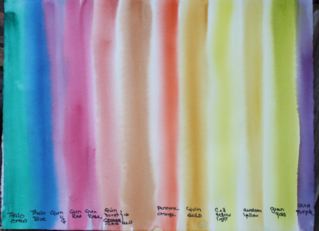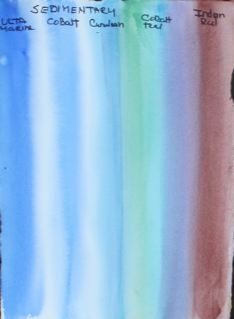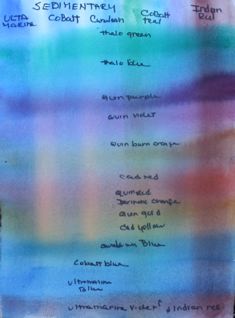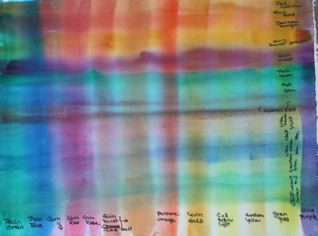Of course you know what your colors look like, one by one, on the white paper, but it takes a while to learn how to anticipate what you will have after you glaze one color over another.

 This is part of a study I found the other day. I made it when Daniel Smith introduced their colors, with many new names and hues that didn’t match those of the same name made by Winsor Newton.
This is part of a study I found the other day. I made it when Daniel Smith introduced their colors, with many new names and hues that didn’t match those of the same name made by Winsor Newton.
Here you can see how I put down squares of four reds: Indian, anthroquinoid, quinacridone red, and cadmium red medium. I crossed them with my four blues, ultramarine, thalo, cobalt and cerulean blue. On the left are the greens over my yellows. To the right yellows over greens, etc.
These are useful but when watercolor is put on dry paper some of its beauty is lost so for this month’s matrix, I tried making wet-on-wet matrix.
 On the right you see a half sheet that was set in water for a few minutes, allowed to drip till it stopped, and then I put down all of the dye colors on my palette: thalo gren, and blue; quin. violet, red, rose and burnt orange; perinone orange, quin. gold, cadmium yellow light, aurolean, green gold, and quin. violet.
On the right you see a half sheet that was set in water for a few minutes, allowed to drip till it stopped, and then I put down all of the dye colors on my palette: thalo gren, and blue; quin. violet, red, rose and burnt orange; perinone orange, quin. gold, cadmium yellow light, aurolean, green gold, and quin. violet.
 On the left is a quarter sheet with my sedimentary paints, again brushed on a wet-on-wet piece of Arches 140 lb cold press. I tried with each of the bands to have a value change from darker to lighter.
On the left is a quarter sheet with my sedimentary paints, again brushed on a wet-on-wet piece of Arches 140 lb cold press. I tried with each of the bands to have a value change from darker to lighter.
Ultramarine blue, cobalt blue, cerulean blue, cobalt teal, ultramarine violet, Indian red.
Below on the left, I have crossed all of the original dye colors with all 20 pigments on my palette.
.
 On the right is the wet-on -wet crossing of the sedimentary colors with the dye colors
On the right is the wet-on -wet crossing of the sedimentary colors with the dye colors
. These matrix may be hard to read. Drawing lines between them with a felt tip pen will isolate them in boxes. Or you can take a small window such as an empty slide and look at them one at a time.
 In this next photo we have thalo blue (bottom) and thalo green, crossing cadmium red, burnt orange, and perinone orange. Notice how the cad. red and the blue make a nice violet but a neutral when the green crosses over it.
In this next photo we have thalo blue (bottom) and thalo green, crossing cadmium red, burnt orange, and perinone orange. Notice how the cad. red and the blue make a nice violet but a neutral when the green crosses over it.

This is the sort of observation you can make after you have done your matrix.
But!!!! This is only wet-on-wet over wet-on-wet. The top one was dry on dry.
What if you wet a strip and then brushed the second color in?
What it you painted a dry stripe over the first grid of wet on wet. Or painted a dry stripe NEXT TO each of the second layer colors you had put down wet on wet? Then you can compare how the colors look when applied wet or applied dry.
Then do a new one comparing dye over dye. Dye over sedimentary. Sedimentary over dye. Wet and dry.
And then start painting, using some of your knowledge — to get neutrals that glow; to get variety in an out of focus area, to go darker and still have resonating color. LEARNING what your colors can do will greatly enlarge your choices.
Have fun!!
Caroline
